Amazing shot of an orangutan high above the rainforest is voted wildlife photo of the year
Tim Laman's vertigo-inducing shot of an orangutan high above the rainforest has won him Wildlife Photographer of the Year 2016.
The winners of the 52nd Wildlife Photographer of the Year competition have been revealed at a ceremony at the Natural History Museum in London. American photographer Tim Laman was named Wildlife Photographer of the Year 2016, beating almost 50,000 entries from 95 countries. His image, Entwined Lives, shows a critically endangered Bornean orangutan making a 30-metre (100-foot) climb up the thickest root of a strangler fig that has entwined itself around a tree emerging high above the rainforest canopy in the Gunung Palung National Park, in West Kalimantan, Indonesian Borneo.

Knowing the orangutan regularly feasted on this tree's figs, Laman spent three days climbing the tree using ropes, setting up several GoPro cameras that could be triggered remotely. He managed to capture a wide‑angle view of the forest below and a view of the orangutan's face from above. Wild orangutans face a crisis of habitat loss due to agriculture and logging. Increased poaching for the illegal pet trade means the species' future seems bleak. "Protecting their remaining habitat is critical for orangutans to survive. If we want to preserve a great ape that retains its vast culturally transmitted knowledge of how to survive in the rainforest and the full richness of wild orangutan behaviour, then we need to protect orangutans in the wild, now," Laman said.
Sixteen-year-old Gideon Knight won the Young Wildlife Photographer of the Year title for his image The Moon and the Crow. Shot near his London home it shows a bird in the twigs of a sycamore tree silhouetted against the dusk sky and the full moon. It "makes it feel almost supernatural, like something out of a fairy tale," he said.
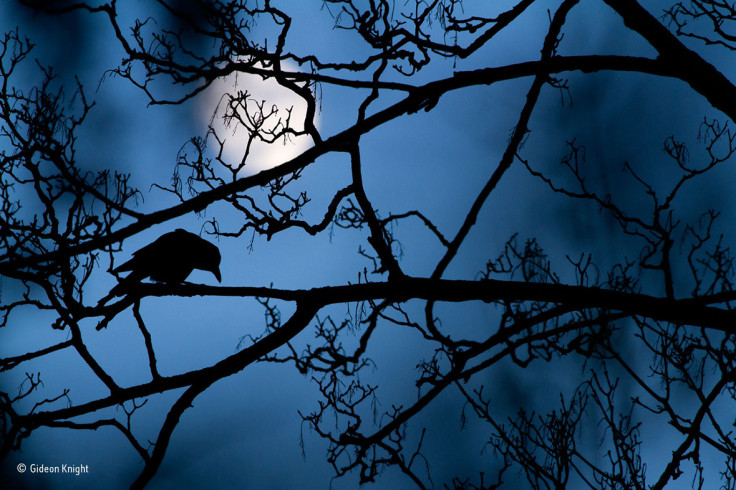
The two images were selected from the winners of 16 categories, such as Urban and Underwater. IBTimes UK presents a selection of the category winners.
Winner, Urban category: The Alley Cat by Nayan Khanolkar, India. At night, leopards slip ghost-like through the maze of alleys in the Aarey Milk Colony in a suburb of Mumbai bordering Sanjay Gandhi National Park, looking for food (especially stray dogs). The Warli people living in the area respect the big cats. Despite close encounters and occasional attacks, the cats are an accepted part of their lives and their culture, seen in the traditional paintings that decorate the walls of their homes. The leopard is not only the most versatile of the world's big cats but possibly the most persecuted. With growing human-leopard conflicts elsewhere grabbing the headlines, Khanolkar was determined to use his pictures to show how things can be different with tolerance and planning. Once he had convinced the Warli people of his plan, they supplied him with valuable information, as well as keeping an eye on his equipment. Positioning his flashes to mimic the alley's usual lighting and his camera so that a passing cat would not dominate the frame, he finally – after four months – got the shot he wanted. With a fleeting look of enquiry in the direction of the camera click, a leopard went about its business alongside people's homes. Khanolkar hopes that those living in Mumbai's new high-rise developments now impinging on the park will learn from the Warli how to co‑exist with the original inhabitants of the land.
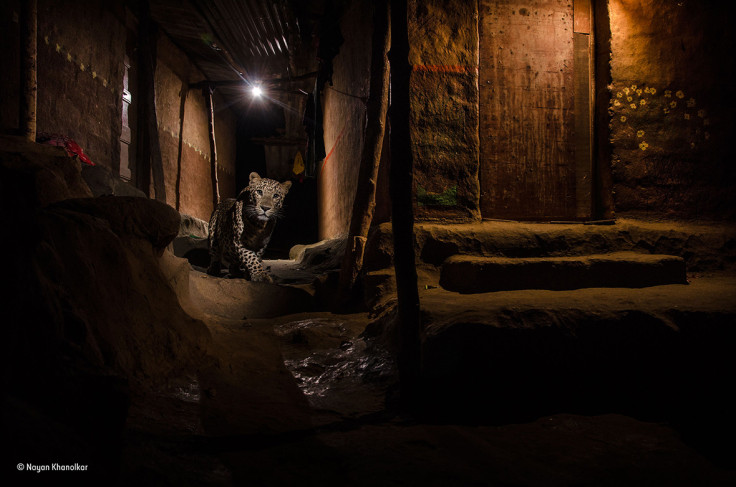
Winner of the Birds category: Eviction Attempt by Ganesh H Shankar, India. These Indian rose-ringed parakeets were not happy. They had returned to their roosting and nesting hole high up in a tree in India's Keoladeo National Park (also known as Bharatpur Bird Sanctuary) to find that a Bengal monitor lizard had taken up residence. The birds immediately set about trying to evict the squatter. They bit the monitor lizard's tail, hanging on for a couple of seconds at a time, until it retreated into the hole. They would then harass it when it tried to come out to bask. This went on for two days. But the action only lasted a couple of seconds at a time and was fast-moving. The branch was high up, and Ganesh had to shoot against the light. Eventually the parakeets gave up and left, presumably to try to find another place to rear their young. These Indian birds are highly adaptable; escaped pet parakeets have founded populations in many countries. In Europe, where they are known as ring-necked parakeets, they are accused of competing for nest holes with some native species, such as nuthatches, and even bats, but in turn, other birds such as starlings are quite capable of evicting the parakeets from their nest holes.
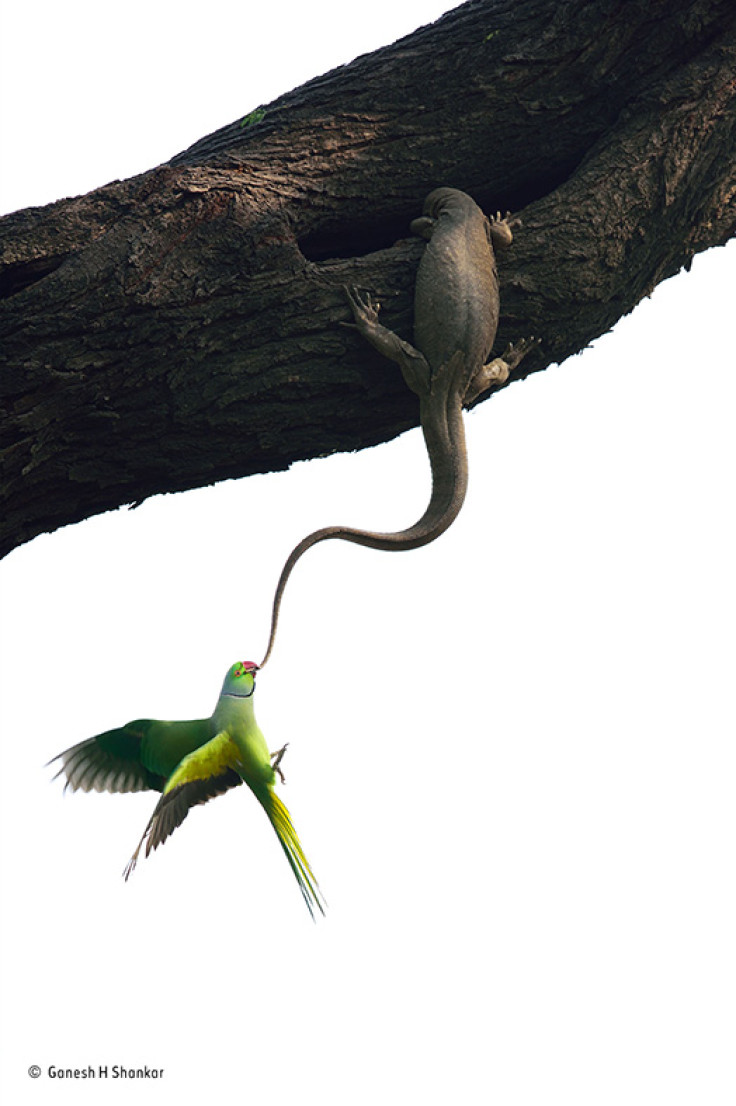
Winner, Impressions category: Star Player by Luis Javier Sandoval, Mexico. As soon as Sandoval slipped into the water, curious young California sea lions came over for a better look. He had arrived the night before at the island of Espíritu Santo in the Gulf of California, sleeping aboard his boat so that he would be ready to dive at sunrise. He had in mind a picture that needed warm light, a slow shutter speed and friendly subjects. One of the pups dived down, swimming gracefully with its strong fore-flippers. It grabbed a starfish from the bottom and started throwing it to Sandoval. "I love the way sea lions interact with divers and how smart they are," he said. The youngsters often use games to hone their skills, especially fishing techniques. As the pup was playing very close to the breaking point of the waves, Sandoval's timing had to be spot-on to frame it in the right place against the movement of the water. Angling his camera up towards the dawn light – just as the pup offered him the starfish and another youngster slipped by close to the rocks – he created his artistic impression of the sea lion's playful nature.

Winner, The Wildlife Photojournalist Award for a single image: The Pangolin Pit by Paul Hilton, UK/Australia. Nothing prepared Hilton for what he saw: some 4,000 defrosting pangolins (5 tons) from one of the largest seizures of the animals on record. They were destined for China and Vietnam for the exotic‑meat trade or for traditional medicine (their scales are thought, wrongly, to treat a variety of ailments). Pangolins have become the world's most trafficked animals, with all eight species targeted. This illegal trade, along with habitat loss and local hunting, means that the four Asian species are now endangered or critically endangered, and Africa's four species are heading that way. These Asian victims, mostly Sunda pangolins, were part of a huge seizure – a joint operation between Indonesia's police and the World Conservation Society – found hidden in a shipping container behind a façade of frozen fish, ready for export from the major port of Belawan in Sumatra. Also seized were 96 live pangolins (destined to be force-fed to increase their size), along with 100 kilos (220 pounds) of pangolin scales (formed from keratin, the same substance in fingernails and rhino horn) worth some $1.8 million on the black market, and 24 bear paws. All had come from northern Sumatra. The dead pangolins were driven to a specially dug pit and then incinerated. The live ones were taken north and released in the rainforest. "Wildlife crime is big business," says Hilton. "It will stop only when the demand stops."
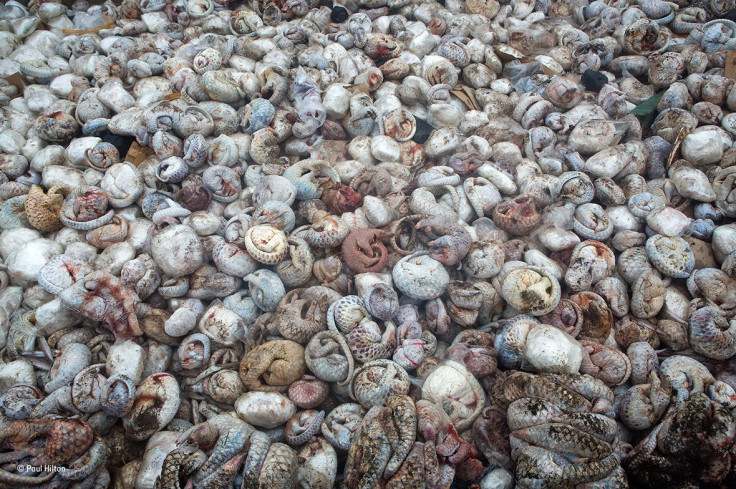
Winner, Plants and Fungi category: Wind Composition by Valter Binotto, Italy. With every gust of wind, showers of pollen were released from a hazel tree near Binotto's home in northern Italy, lit up by the winter sunshine. To create the dark background, he positioned himself to backlight the flowers. Hazel has both male and female flowers on the same tree, though the pollen must be transferred between trees for fertilisation. Each catkin comprises an average of 240 male flowers, while the female flower is a small bud-like structure with a red-tufted stigma. The pollen-producing catkins open early in the year, before the leaves are out, and release huge amounts of pollen to be carried away by the wind. And now recent research suggests that bees may also play a role. The catkins are an important source of pollen for early bees and have a bee‑friendly structure, while the red colour of the female flowers may entice insects to land on them. "The hardest part was capturing the female flowers motionless while the catkins were moving," explains Binotto. "I searched for flowers on a short branch that was more stable." Using a long exposure to capture the pollen's flight and a reflector to highlight the catkins, he took many pictures before the wind finally delivered the composition he had in mind.

Winner, Underwater category: Snapper Party by Tony Wu, USA. For several days each month (in tandem with the full moon), thousands of two‑spot red snappers gather to spawn around Palau in the western Pacific Ocean. The action is intense as the fish fill the water with sperm and eggs, and predators arrive to take advantage of the bounty. Having read about the drama, Wu couldn't understand why there were so few photos of it – until he hit the water there for the first time, in 2012. The currents were unrelenting – ideal for eggs to be swept swiftly away but a struggle for him to keep up with the fast‑moving fish. Also, the light was low, and the water was clouded with sperm and eggs. That first attempt failed, but he has returned every year to try to capture the event. Noticing that the spawning ran "like a chain reaction up and down the mass of fish", his success finally came when he positioned himself so that the action came to him. Rewarded with a grandstand view, he was intrigued to see that the fish rapidly changed colour during mating from their standard red to a multitude of hues and patterns. Even their characteristic two white spots, close to the dorsal fin on their back, seemed to fade and reappear. On this occasion, with perfect anticipation, he managed to capture a dynamic arc of spawning fish amid clouds of eggs in the oblique morning light. Still obsessed by the dynamics and magnitude of this natural wonder, he will be returning to Palau next April to witness once again the spectacular snapper party.
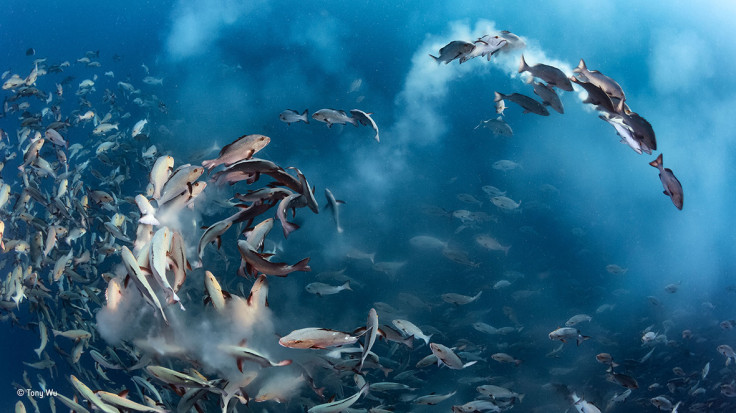
Winner, Black and White category: Requiem for an Owl by Mats Andersson, Sweden. Every day in early spring, Andersson walked in the forest near his home in Bashult, southern Sweden, enjoying the sights and sounds of a pair of Eurasian pygmy owls – until the night he found one of them lying dead on the forest floor. "The owl's resting posture reflected my sadness for its lost companion," he recalls. Working in black and white he captured the melancholy of the moment, framing the solitary owl within the bare branches, lit by the first light of dawn. Not long after, he found this owl dead, too, and suspects that it and its mate may have been killed by one of the larger owls in the forest, not for food but because, in the breeding season, it didn't tolerate other birds of prey in its territory. Pygmy owls are the smallest owls in Europe, barely 19 centimetres (7½ inches) long. They hunt in the day. Nesting in tree cavities, especially in conifer woodland, they form pair bonds in autumn that last through to spring and sometimes for more than one breeding season.

Winner, Details category: The Sand Canvas by Rudi Sebastian, Germany. The pristine white sand of Brazil's Lençóis Maranhenses National Park offers a blank canvas to the rain. In the dry season, sand from the coast is blown by powerful Atlantic winds as far as 50 kilometres (30 miles) inland, sculpting a vast expanse of crescent-shaped dunes up to 40 metres (130 feet) high. With the onset of the rains, the magic begins. An impermeable layer beneath the sand allows water to collect in the dune valleys, forming thousands of transient lagoons, some more than 90 metres (295 feet) long. Bacteria and algae tint the clear water in countless shades of green and blue, while streams carrying sediment from the distant rainforest make their mark with browns and blacks. Patterns appear as the water evaporates, leaving behind organic remains. Sebastian learned about the park on a TV programme, and planned his trip almost two years ahead, making sure he would be able to stay until the water level was right. He waited several days for the perfect light – overhead, to bring out the colours but with clouds obscuring any direct sun "to get a shadowless purity". Shooting almost vertically down from a small aircraft with the door removed, avoiding perspective or scale, he created his striking image. A few weeks later, the scene had evaporated.
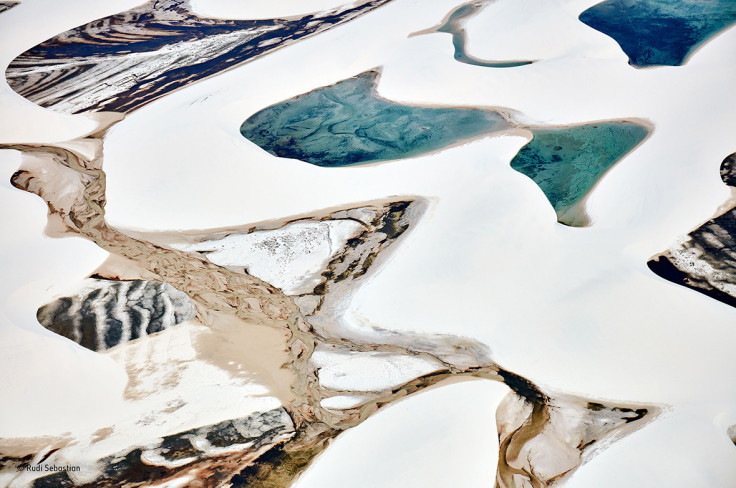
The hugely popular annual Wildlife Photographer of the Year exhibition, featuring 100 images selected by an international panel of judges, opens at the Natural History Museum on 21 October 2016 before touring the UK and several other countries including Spain, Canada, the USA, Germany and Macau.
The next Wildlife Photographer of the Year Competition will open for entries from 24 October to 15 December 2016.
© Copyright IBTimes 2024. All rights reserved.






